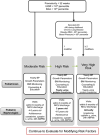Prematurity and future kidney health: the growing risk of chronic kidney disease
- PMID: 29432217
- PMCID: PMC6085891
- DOI: 10.1097/MOP.0000000000000607
Prematurity and future kidney health: the growing risk of chronic kidney disease
Abstract
Purpose of review: The purpose of this review is to describe the role prematurity plays in the development of chronic kidney disease (CKD) and to discuss potential reasons for this association including decreased nephron mass, as well as postnatal insults such as neonatal acute kidney injury (nAKI).
Recent findings: New observational studies in humans and experimental studies in animal models have strengthened the association between prematurity, low birth weight and CKD. Growing evidence suggests increased susceptibility to CKD is caused by decreased nephron mass at birth. Beginning with a low nephron count may cause only subtle abnormalities during childhood, however may result in CKD, hypertension and albuminuria in adolescence or adulthood. Recent studies in premature infants reveal a high incidence of nAKI, which may also contribute to ongoing CKD risk.
Summary: Children born at low birth weights (both due to prematurity and/or intrauterine growth restriction) show increased risk of kidney dysfunction during adulthood. A better understanding of the modulators of nephron mass in premature infants as well as the effects of the extrauterine environment is essential. Additionally, improved awareness of at-risk infants is important as is early evaluation and detection of kidney dysfunction, allowing interventions to slow the progression to CKD.
Conflict of interest statement
Conflicts of interest
None
Figures



References
-
- Horbar JD, Carpenter JH, Badger GJ, et al. Mortality and neonatal morbidity among infants 501 to 1500 grams from 2000 to 2009. Pediatrics. 2012;129(6):1019–26. - PubMed
-
- Wilson-Costello D, Friedman H, Minich N, et al. Improved Survival Rates With Increased Neurodevelopmental Disability for Extremely Low Birth Weight Infants in the 1990s. Pediatrics. 2005;115(4):997–1003. - PubMed
-
- Kaddourah A, Basu RK, Bagshaw SM, Goldstein SL. Epidemiology of Acute Kidney Injury in Critically Ill Children and Young Adults. N Engl J Med. 2017;376(1):11–20. This is the first multi-center prospective study evaluating AKI in critically ill pediatric patients, evaluating mortality trends and complications. - PMC - PubMed
Publication types
MeSH terms
Grants and funding
LinkOut - more resources
Full Text Sources
Other Literature Sources
Medical
Research Materials

